The mission to rendezvous with an asteroid the size of the Empire State Building before it hurtles past Earth: the European Space Agency’s Ramses spacecraft will rendezvous with Apophis in 2029 and accompany it on its “potentially dangerous” journey to our planet
Despite appearances, Friday, December 13, 2029, will be an extraordinarily lucky day for humanity, as an asteroid the size of the Empire State Building zooms past Earth.
Scientists are now convinced that the perilous collision of space rock 99942 Apophis with Earth could be the best chance we have of learning how to avoid a catastrophic asteroid collision.
The European Space Agency (ESA) has announced funding for the Rapid Apophis Mission for Security and Safety (Ramses), which will track the asteroid during its flyby.
With Apophis rapidly approaching Earth, ESA needs to launch its new spacecraft in just four years to arrive at the asteroid in time.
But if they can accomplish this daunting task, studying Apophis’s response to Earth’s gravity could reveal the secret to deflecting deadly asteroids.
The European Space Agency (ESA) has announced funding for the Rapid Apophis Mission for Security and Safety (Ramses), which will accompany the asteroid during its flyby
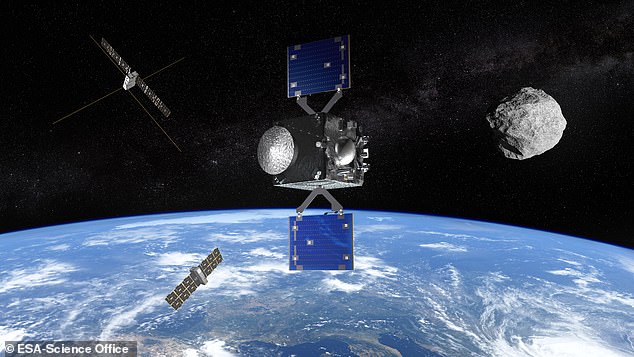
Ramses (pictured) will attempt to observe how the asteroid is squeezed and pulled by Earth’s gravity to learn more about how asteroids are affected by external forces
When astronomers discovered in 2004 that Apophis was heading directly toward Earth, the scientific community was understandably concerned.
Just 10 years ago, in 1994, scientists watched in awe as chunks of Comet Shoemaker-Levy 9 slammed into Jupiter with incredible force.
This raised the uncomfortable question of what humanity would do if Apophis caused a similar collision with our own planet.
Fortunately, in 2021 it was discovered that Apophis would miss Earth during its flybys in 2029 and 2036, but for many the distance may be too close.
Apophis will pass Earth at a distance of only 32,000 kilometers, which is one-tenth the distance from Earth to the Moon.
At that distance, Apophis is closer than the geostationary communications satellites and will be visible to the naked eye in clear, dark skies to about two billion people across much of Europe, Africa and parts of Asia.
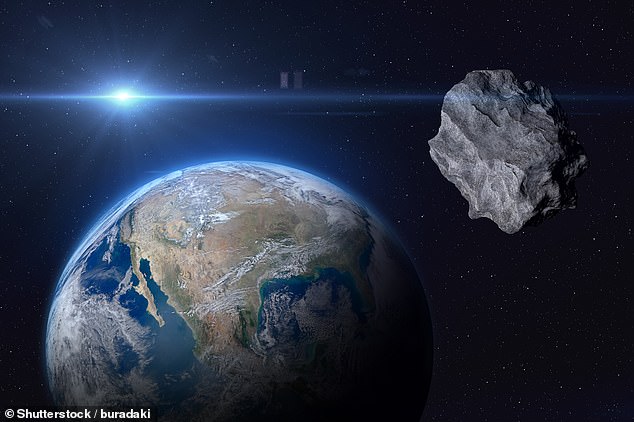
Asteroid 99942 Apophis is expected to pass close to Earth on April 13, 2029. The asteroid will be so close that it will be visible to the naked eye on clear nights (stock image)
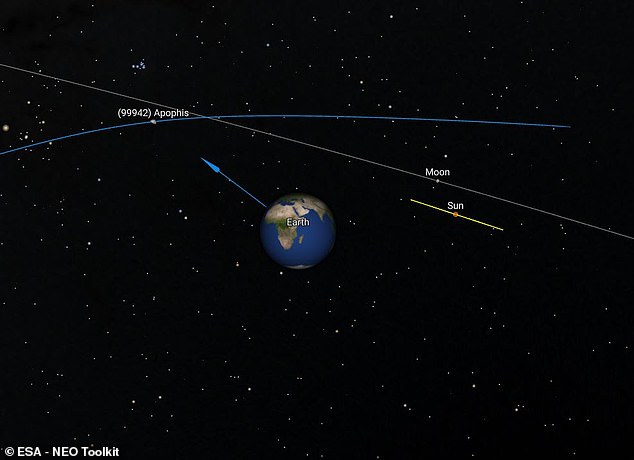
As shown in this diagram, asteroid 99942 Apophis will pass Earth at a distance of only 32,000 km (20,000 miles), one-tenth the distance to the Moon.
While that may seem like a daunting prospect, it is a fantastic opportunity for science.
Dr Patrick Michel, research director at the French National Centre for Scientific Research, said: ‘There is still so much we don’t know about asteroids, but until now we had to travel deep into the solar system to study them and perform experiments ourselves to interact with their surfaces.
‘For the first time ever, nature brings one to us and performs the experiment itself.’
During the closest approaches to Earth, Apophis will be so close that it will begin to take shape due to the planet’s strong gravity.
Dr Michel explains: ‘All we have to do is watch as Apophis is stretched and compressed by strong tidal forces. This can trigger landslides and other disruptions, and bring new material from beneath the surface.’
The Ramses spacecraft will attempt to rendezvous with Apophis before it makes its closest approach to Earth and will follow it throughout its journey.
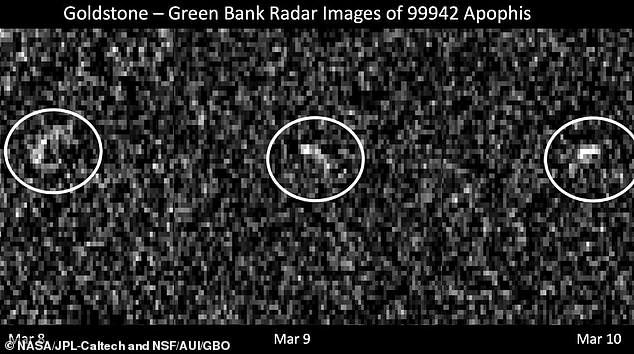
After Apophis was discovered in 2004, radar images taken in 2021 (see photo) showed that Apophis would not hit Earth, but would pass close enough to be shaped by Earth’s gravity.
Ramses will then use a range of scientific equipment to capture the first images of what happens to an asteroid as it passes close to Earth.
The spacecraft will conduct a thorough before and after study of the asteroid’s shape, surface, orbit, rotation and orientation.
By observing how these change during the flyby, scientists can better learn how asteroids respond to external forces.
That knowledge is crucial for future missions aimed at keeping dangerous asteroids out of Earth’s orbit.
Richard Moissl, head of ESA’s Planetary Defence Office, said: ‘First, a reconnaissance mission would be launched to analyse the orbit and structure of the incoming asteroid.
‘The results will be used to determine how best to redirect the asteroid or to rule out the possibility that no impacts have occurred, before developing an expensive deflector mission.’
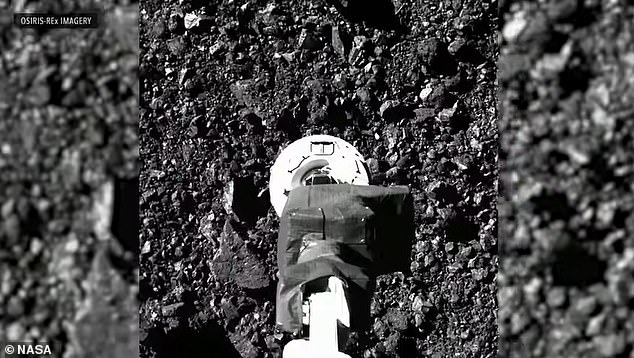
Like NASA’s Osiris-Rex mission (pictured), Ramses will attempt to approach Apophis to gather information about how the asteroid is changing under Earth’s gravity
Space agencies around the world are already investigating ways to divert incoming space rocks from a dangerous path.
In 2022, NASA’s Dart Mission crashed a spacecraft into the side of the asteroid Dimorphos to see if the impact would move it.
Later this year, ESA’s planetary defence mission Hera will be launched to investigate the aftermath of the collision.
Ramses won’t be traveling to Apophis alone, however, as NASA’s own mission is already en route to the asteroid.
Last year, the space agency’s Osiris-Rex mission successfully recovered chunks of rock from the 4.6 billion-year-old asteroid Bennu.
After the original mission was completed, NASA announced that the same spacecraft would attempt an encounter with Apophis in 2029, under the new name Osiris-Apex.
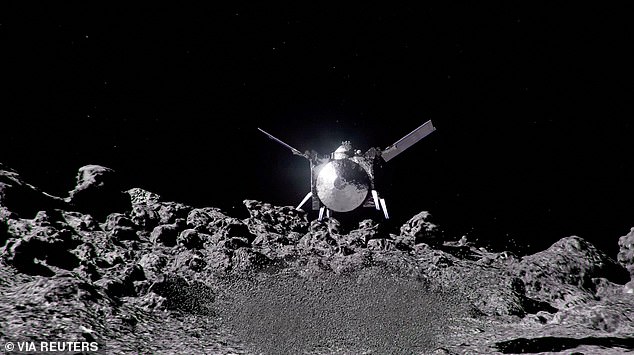
NASA will also send the same spacecraft used in Osiris-Rex (pictured) to rendezvous with Apophis about a month after it passes by Earth to investigate the aftermath of its flyby
Osiris-Apex will arrive at Apophis about a month after the Earth pass, allowing scientists to study the aftermath of the pass in more detail.
According to ESA, the data collected by Apophis is just part of how the mission can better prepare humanity for threats from space.
To reach Apophis before it reaches Earth, the spacecraft would need to launch in just four years, an extremely tight schedule by space travel standards.
Sending a spacecraft into space as quickly as possible to learn more about an approaching asteroid could make the difference between a catastrophe and diverting the space rock in time.
Dr. Moissl adds: ‘Ramses will demonstrate that humanity can carry out a reconnaissance mission to impact an approaching asteroid within a few years.
“These types of missions are the cornerstone of humanity’s response to a dangerous asteroid.”
